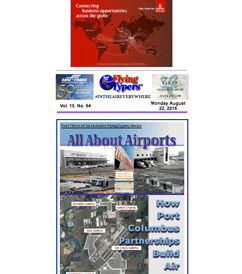
The
latest airline financials illustrate just how hard the
sector has been hit by weak cargo markets, but new product
launches could now be starting to boost demand.
Following on from positive
signals in June, July Purchasing Manager Indexes and
export data suggest high-value manufacturing activity
in Asia is warming up. “PMIs are stabilized and
there are signs that launches by Samsung and Apple are
providing some support to electronics production as
suppliers stock up,” said HSBC.
But the picture was mixed,
with PMIs across most of South East Asia contracting
last month while key exporters such as China, Taiwan,
Vietnam, and South Korea—as well as less established
players in air freight markets such as Australia, New
Zealand, and India—all saw manufacturing expand.
The upturn in PMI data
was also reflected in the latest air traffic figures
from Asia. Guangzhou Baiyun Airport reported an 8 percent
year-on-year increase in cargo throughput in July while
Shenzhen Airport saw an 11 percent surge. Elsewhere,
the latest figures were only available for June, but
Bangkok Suvarnabhumi International registered a 7 percent
increase in freight handles and Singapore’s Changi
airport saw a 7.8 percent hike.
Hong Kong International
Airport (HKIA), the world’s leading freight airport,
also saw steady growth in July when cargo throughput
rose 4.7 percent year-on-year to increase to 380,000
tons. “A robust 15 percent year-on-year growth
in transshipments led to respectable growth in cargo
volume last month,” read a statement from HKIA.
“Traffic to/from key trading regions in North
America, Mainland China, and Southeast Asia rose most
significantly in July.”
Singapore Airlines saw
a 10.5 percent surge in tonnage in July, while combined
Cathay Pacific and Dragonair traffic figures for July
2016 revealed an increase in cargo and mail of 7.1 percent
year-on-year as well as a 2.9 percent load factor uptick.
 “Helped
by strong perishable exports from the Americas, the
overall tonnage for July remained healthy, although
revenues continue to be affected by dampened yields,”
said Cathay Pacific General Manager Cargo Sales &
Marketing Mark Sutch. “Helped
by strong perishable exports from the Americas, the
overall tonnage for July remained healthy, although
revenues continue to be affected by dampened yields,”
said Cathay Pacific General Manager Cargo Sales &
Marketing Mark Sutch.
“We saw month-end
pick-up and a stronger feed out of our home market and
Southeast Asia. Demand to both the Americas and India
was strong, while we were able to capture more exports
out of mainland China due to a reduction in the overall
market capacity. The business environment remains challenging,
but we have seen a growth in demand for special products
and we will continue to diversify.”
But despite the more recent
improvement in demand, Asia Pacific airlines are desperate
also for an upturn in yields in the second half of 2016
if they are to claw back first half losses.
For example, Cathay Pacific
1H16 net profit tumbled 82 percent year-on-year due
to intense competition, adverse currency movements,
and weak premium passenger demand.
“Cargo yield fell
18 percecnt y-o-y to the lowest level in a decade in
light of chronic overcapacity and lower fuel surcharges,”
added HSBC in an analyst’s note.
Qantas reported a major
gains in underlying profit in the year ending June 30,
but Qantas Freight saw underlying EBIT of $64 million,
down 44 percent year-on-year.
“The result reflects
difficult global cargo markets and the end of favorable
legacy agreements with Australian Air Express, impacting
yields,” said the airline.
On a more upbeat note
the carrier added: “The business is well-positioned
for the future. New long-term deals with Australia Post
and Toll, the country’s two biggest freight customers,
are in place in the domestic market. Qantas Freight
is also pursuing new opportunities internationally,
in particular on triangular Australia-China-U.S. routes.”
A spokesman for Air France-KLM-Martinair
Cargo said recent improvements on lanes out of Asia
as well as a number of expected product launches were
helping demand. But he said the positive trends had
also been influenced by capacity corrections.
“We are given to
understand that the three main Chinese carriers have
temporarily suspended some of their freighter operations,
particularly those flying between China and the U.S.,
either on account of fleet maintenance or because of
a part shift of capacity to additional passenger frequencies
being flown in the summer months to match the peak in
passenger demand due to holidays,” he said.
 “Having said that,
July and August historically are months when demand
to the U.S. peaks as stores across the U.S. start to
stock inventory for Thanksgiving and Black Friday.” “Having said that,
July and August historically are months when demand
to the U.S. peaks as stores across the U.S. start to
stock inventory for Thanksgiving and Black Friday.”
However, he added that
inbound demand to Europe from Asia remained flat, a
note of caution also supported by Paul Tsui, (left)
managing director of forwarding and logistics operator
Janel Group and the immediate past chairman of the Hong
Kong Association of Freight Forwarding and Logistics
and the Federation of Asia Pacific Aircargo Associations.
“We do not see significant
demand out of China, but overall space is a bit tight
due to the summer holiday traveling season and the start
of the new school terms,” he said. “It’s
pretty much the same scenario for Hong Kong and China
and although overall space is a bit tight, the price
remains the same as before—there are no signs
of a rate increase at all.
“For demand ex-Asia
for the rest of the year, it’s not very promising
and will remain difficult, but shall pick up by end-September
for Christmas season shipping.”
SkyKing |





